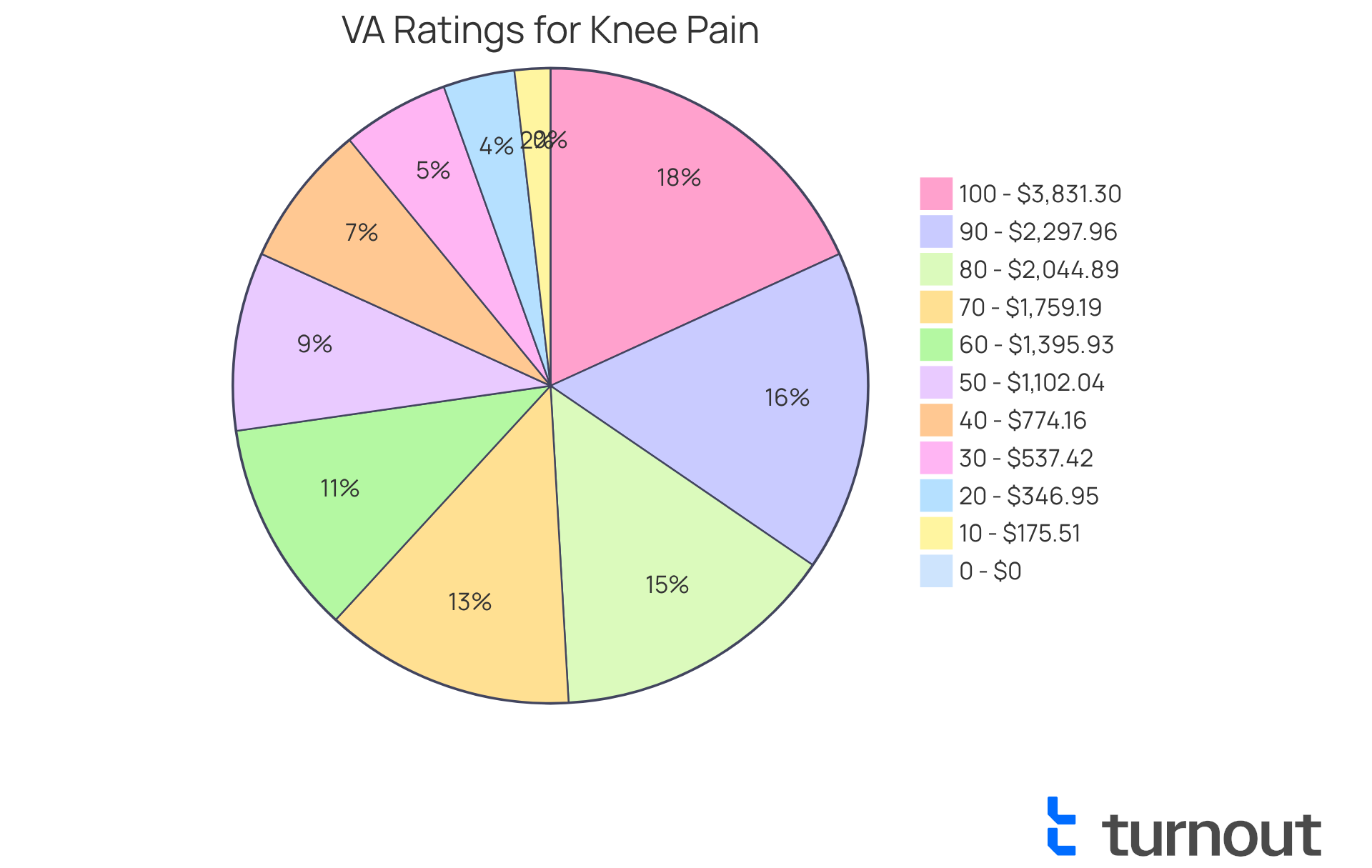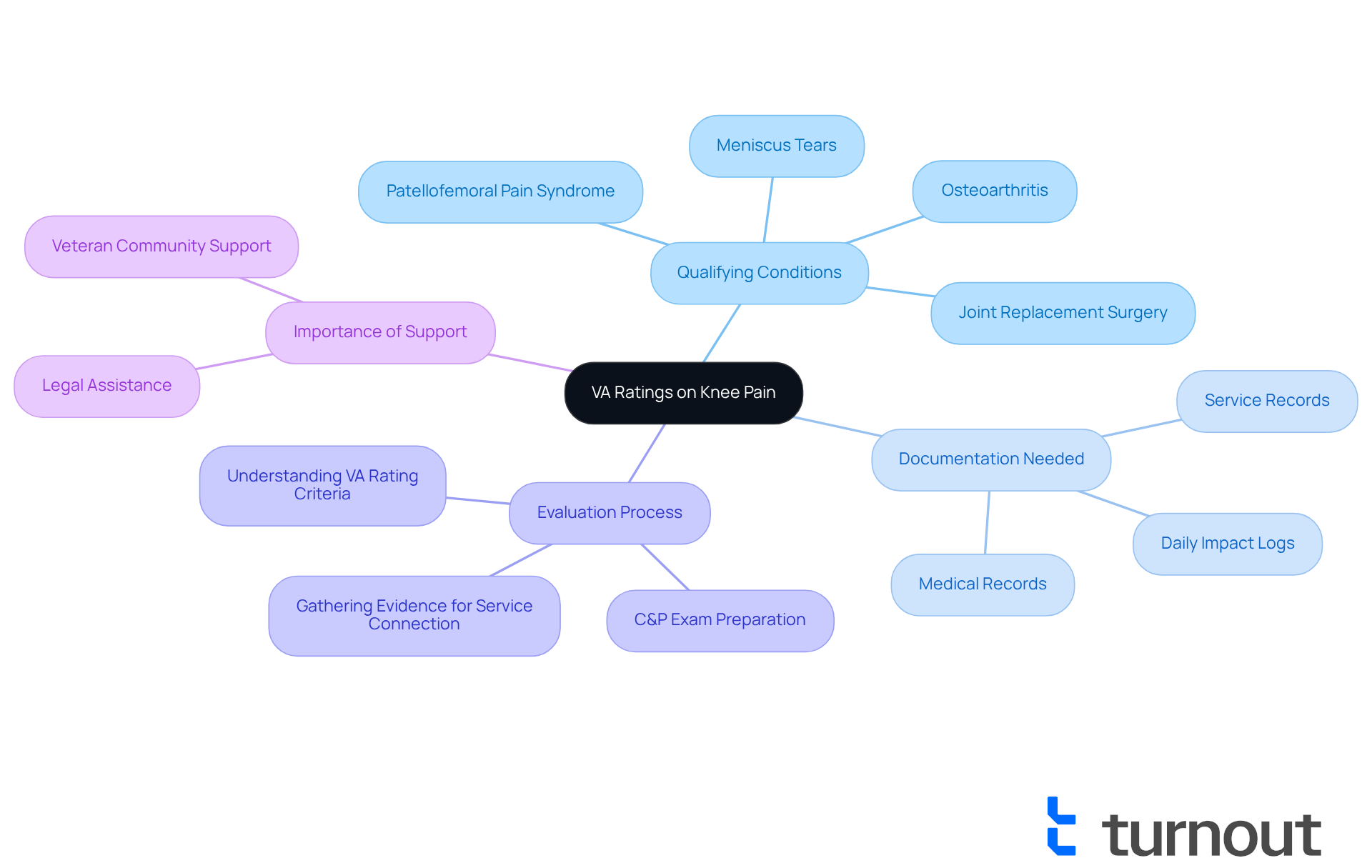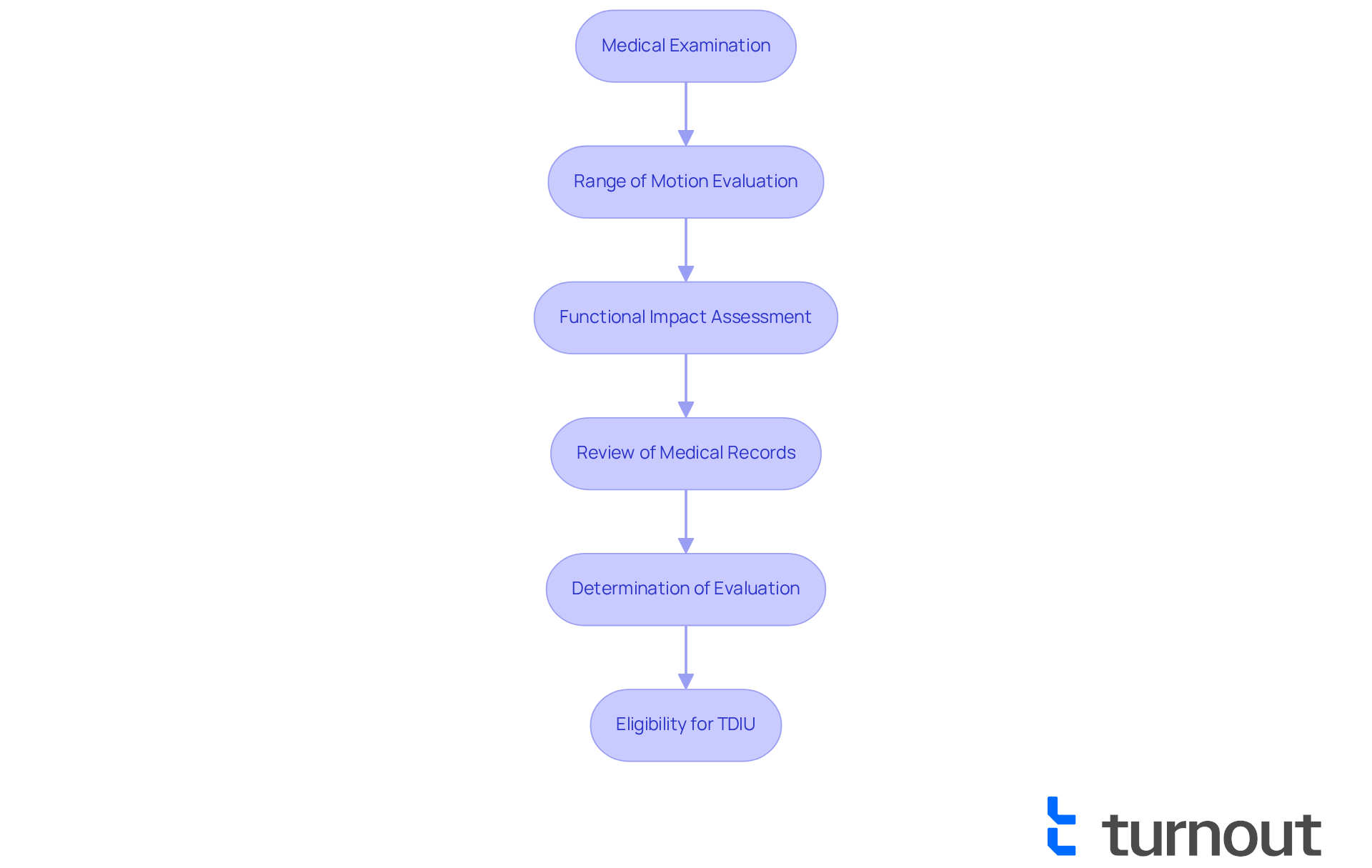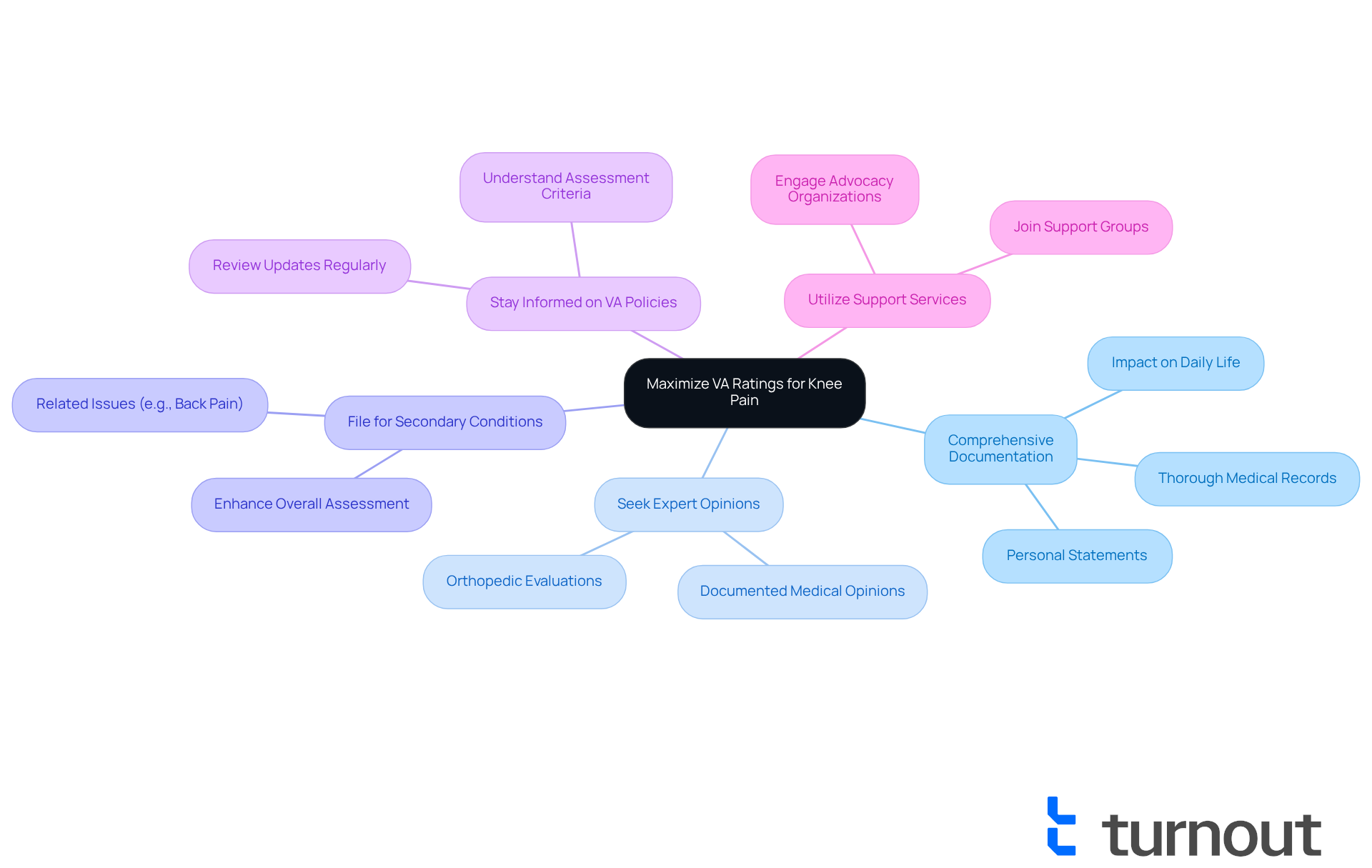Overview
Navigating the VA ratings process for knee pain can feel overwhelming for veterans. We understand the challenges you face, and it’s essential to highlight the significance of accurate documentation and understanding qualifying conditions. This journey requires thorough medical records and expert evaluations, which are crucial for establishing a service connection.
By ensuring that your records are complete and well-documented, you can maximize your disability ratings. This, in turn, can have a profound impact on the financial support and healthcare benefits you receive. Remember, you are not alone in this process; we’re here to help you every step of the way.
Take the time to gather your medical history and seek evaluations from professionals who understand your needs. It’s common to feel uncertain about what to do next, but each step you take brings you closer to the support you deserve. Together, we can navigate this path toward securing the benefits that honor your service.
Introduction
Navigating the complexities of VA ratings for knee pain can feel overwhelming for many veterans. We understand that this process is vital for securing the benefits you deserve. The ratings range from 0% to 100%, and they directly impact your financial support and access to healthcare services. It’s essential to grasp how your conditions are evaluated.
However, it’s common for veterans to remain unaware of the specific qualifying conditions and strategies that can significantly enhance their ratings. What steps can you take to ensure your knee pain is accurately assessed and adequately compensated? We’re here to help you understand this crucial journey.
Define VA Ratings and Their Importance for Knee Pain
VA evaluations are percentages determined by the Department of Veterans Affairs (VA) that indicate the extent of a service-related disability. For knee discomfort, the VA rating for knee pain can vary from 0% to 100%, with greater percentages signifying more serious impairments. We understand that comprehending these assessments is essential, as they directly influence the monthly pay an ex-service member receives and their eligibility for extra benefits like healthcare and vocational rehabilitation.
For example, in 2025, an experienced individual with a 10% assessment receives $175.51 monthly, while a 100% assessment provides $3,831.30. An increased assessment for joint discomfort can greatly improve a service member's quality of life by leading to a higher VA rating for knee pain, which provides essential financial assistance and access to crucial healthcare services. Furthermore, former service members are encouraged to record their experiences with knee pain and any related conditions, as this documentation may positively impact their VA rating for knee pain, leading to greater evaluations and increased compensation.
It's common to feel uncertain about the evaluation process, but the bilateral factor can also significantly influence combined disability evaluations, potentially altering them from 20% to 30% or 90% to 100%. Collaborating with supportive groups, like those offered by Turnout, can make a significant difference in achieving the recognition that former service members deserve. Turnout facilitates access to government benefits and financial assistance, providing guidance in navigating the VA claims process and assisting individuals in obtaining the benefits they deserve.
Practical instances emphasize this effect; individuals who effectively manage the evaluation procedure frequently mention enhanced living situations and diminished stress related to their healthcare requirements. Remember, we're here to help you through this journey. It is essential to understand that Turnout is not a legal practice and does not offer legal representation; rather, they employ trained nonlegal advocates to support service members in their claims process.

Identify Qualifying Conditions for VA Ratings on Knee Pain
To qualify for a VA rating for knee pain, veterans must demonstrate that their issue is linked to their service. We understand that navigating this process can be challenging, and we are here to help. Common conditions that may qualify include:
- Osteoarthritis: This degenerative joint disease often results from injuries sustained during military service, leading to chronic pain and reduced mobility.
- Meniscus Tears: These injuries involve damage to the cartilage in the joint, frequently caused by trauma or overexertion during service.
- Patellofemoral Pain Syndrome: Characterized by pain around the kneecap, this issue can develop from repetitive stress or injury, impacting daily activities.
- Joint Replacement Surgery: Veterans who have had joint replacement due to service-related injuries may qualify for increased disability evaluations, reflecting the severity of their condition. A temporary 100% disability assessment is granted for one year post-surgery, after which ongoing evaluations are determined based on specific symptoms.
To bolster your assertions, it is crucial for former military personnel to gather thorough medical documentation and service records that clearly connect their joint pain to their military service. This evidence is vital for establishing the required service connection and obtaining suitable VA evaluations. Moreover, we encourage former service members to record any additional ailments associated with their knee injuries, as these can also influence their VA rating for knee pain. Understanding the specific VA rating for knee pain, which is determined by the restriction of flexion and extension, is essential, as the VA allocates ratings from 0% to 60% depending on the severity of the issue. It's common to feel undervalued; statistics indicate that 80% of former service members may not receive the benefits they deserve. The Compensation & Pension (C&P) exam is an essential stage in the assessment process. We urge former service members to prepare thoroughly to ensure their circumstances are accurately evaluated. Remember, veterans may obtain several evaluations for various elements of their leg issue, which can greatly impact their total benefits. You are not alone in this journey; we are here to support you every step of the way.

Explain How VA Ratings for Knee Pain Are Determined
The evaluation process that determines VA ratings for knee pain includes several key components.
-
First, veterans will undergo a medical examination. Here, a VA healthcare provider evaluates the severity of their joint condition, focusing on both physical symptoms and medical history. We understand that this can be a daunting step, but it’s essential for your care.
-
Next, the range of motion evaluation takes place. The assessor gauges the joint's range of motion, which is crucial for establishing your assessment. For instance, restricted range of motion can result in evaluations varying from 10% to 30%, based on the extent of limitation. If you have verified arthritis through X-ray evidence, you may obtain a 10 or 20 percent disability assessment, depending on severity and whether it impacts one or both joints.
-
Another important aspect is the functional impact assessment. The examiner will look at how joint discomfort influences your daily activities and capacity to work. This evaluation considers factors such as pain intensity and the occurrence of flare-ups, which can significantly affect your overall score. Remember, the VA should assess functional loss when considering the VA rating for knee pain, taking these factors into account.
-
Additionally, the VA reviews all pertinent medical records. This includes treatment history and imaging studies such as X-rays or MRIs. It’s essential for former service members to document any additional issues linked to knee injuries, as these can greatly enhance VA compensation.
-
Ultimately, your evaluation is determined by the seriousness of your situation, with detailed standards outlined in the VA's Schedule for Assessing Disabilities. For example, an experienced individual with a good range of motion but facing discomfort may still receive a designation under Diagnostic Code 5003 for arthritis. Furthermore, if each issue involves different movements, former service members may be eligible for various disability ratings for joint issues. Understanding these factors can assist you in preparing for your evaluations and ensuring you provide all necessary information to support your claims.
-
Lastly, if you have joint conditions that hinder you from maintaining productive employment, you may be eligible for Total Disability due to Individual Unemployability (TDIU). Utilizing tools like the Disability Benefits Questionnaire (DBQ) can also provide additional documentation for the VA to assess the effects of leg injuries. Remember, we’re here to help you through this journey, and you are not alone.

Explore Strategies to Maximize VA Ratings for Knee Pain
If you're a veteran struggling with knee pain, know that you're not alone, and there are ways to maximize your VA rating for knee pain to receive the support you deserve. Here are some compassionate strategies to consider:
-
Comprehensive Documentation: It's essential to ensure that all your medical records, treatment histories, and personal statements are thorough and well-organized. This documentation should clearly outline the seriousness of your joint issue and its impact on your daily life. Remember, thorough medical evidence is crucial for establishing a service connection and determining the extent of your disability.
-
Seek Expert Opinions: Consider acquiring evaluations from orthopedic specialists who can provide detailed assessments of your joint issue. Properly documented medical opinions are vital for linking your disability to military service, and they can significantly strengthen your claim.
-
File for Secondary Conditions: If your knee pain has led to other issues, such as back pain or mobility problems, you might want to think about filing claims for these secondary conditions as well. This approach can potentially enhance your overall disability assessment.
-
Stay Informed on VA Policies: Regularly reviewing updates on VA policies and assessment criteria is important, as these can change and may affect your evaluation process. Understanding the significance of accurately depicting your symptoms can help you navigate the claims process successfully.
-
Utilize Support Services: Engaging with advocacy organizations or support groups that specialize in VA claims can provide you with valuable insights and assistance throughout this journey. These resources can guide you and improve your chances of a successful claim.
By implementing these strategies, you can enhance your chances of receiving a favorable VA rating for knee pain. Remember, we're here to help you through this process, and you deserve the support you need.

Conclusion
Understanding VA ratings for knee pain is vital for veterans seeking the support they deserve. These ratings not only reflect the severity of their condition but also play a crucial role in determining monthly compensation and eligibility for additional benefits. By grasping the intricacies of the VA evaluation process, veterans can navigate the complexities of their claims and significantly improve their quality of life.
We recognize that the journey can feel overwhelming. This article highlights essential aspects, including:
- The importance of thorough medical documentation
- The role of expert opinions
- The potential for filing claims for secondary conditions linked to knee pain
It also emphasizes the evaluation process, which includes:
- Medical examinations
- Range of motion assessments
- Functional impact evaluations
By actively engaging with advocacy groups and staying informed about VA policies, veterans can enhance their chances of receiving favorable ratings.
Ultimately, maximizing VA ratings for knee pain requires a proactive approach. Veterans are encouraged to leverage available resources, document their experiences meticulously, and seek expert guidance to ensure their claims are robust. Remember, the journey may be challenging, but the potential benefits—financial assistance, healthcare access, and improved quality of life—are well worth the effort. You are not alone in this journey, and we’re here to help you every step of the way.
Frequently Asked Questions
What are VA ratings and why are they important for knee pain?
VA ratings are percentages assigned by the Department of Veterans Affairs that indicate the severity of a service-related disability, including knee pain. These ratings range from 0% to 100%, with higher percentages indicating more serious impairments. They are important because they directly affect the monthly compensation and eligibility for additional benefits such as healthcare and vocational rehabilitation for ex-service members.
How much compensation can a veteran receive based on their VA rating for knee pain?
In 2025, a veteran with a 10% VA rating for knee pain receives $175.51 monthly, while a 100% rating provides $3,831.30 monthly. Higher ratings can significantly enhance a veteran's quality of life by providing essential financial assistance and access to healthcare services.
What should veterans do to improve their VA rating for knee pain?
Veterans are encouraged to document their experiences with knee pain and any related conditions, as this documentation can positively influence their VA rating. This may lead to higher evaluations and increased compensation.
How does the bilateral factor affect VA disability evaluations?
The bilateral factor can significantly impact combined disability evaluations, potentially increasing them from 20% to 30% or from 90% to 100%. This factor considers the combined effects of disabilities on both sides of the body.
How can organizations like Turnout assist veterans with the VA claims process?
Turnout provides support by facilitating access to government benefits and financial assistance. They help guide veterans through the VA claims process and assist in obtaining the benefits they deserve, although they do not provide legal representation.
What benefits do veterans report from effectively managing the VA evaluation process?
Veterans who successfully navigate the evaluation process often report improved living situations and reduced stress related to their healthcare needs.




